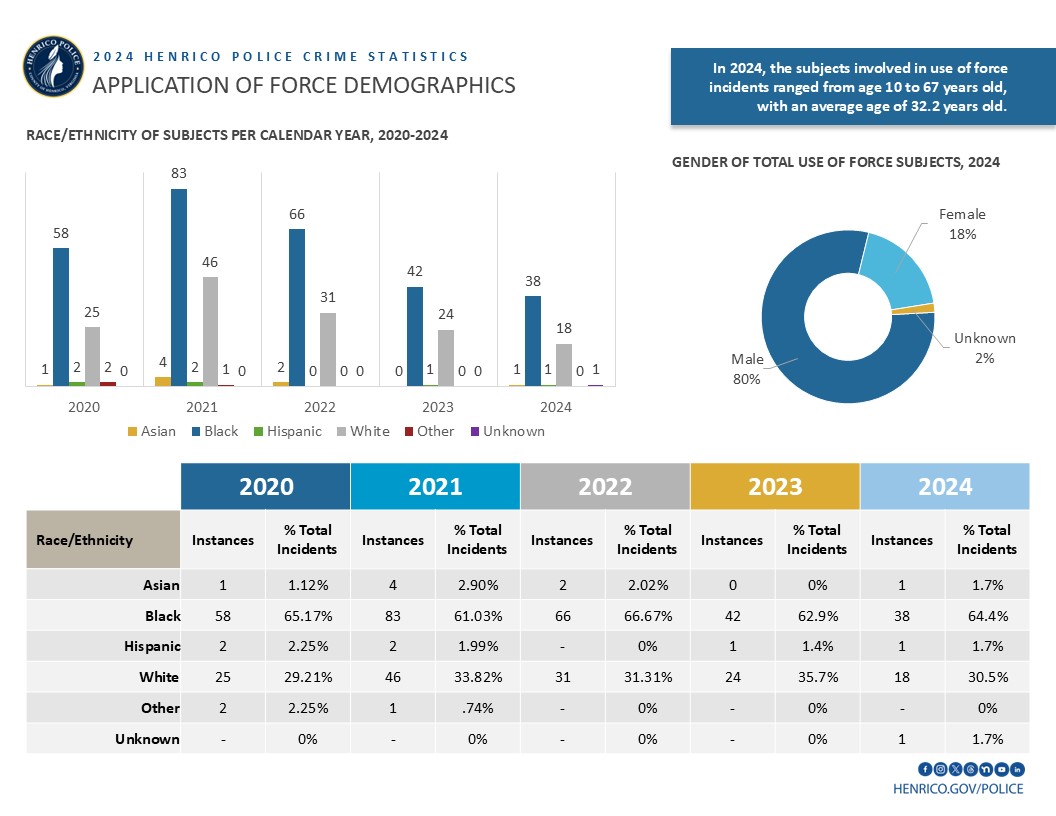
POLICE TRANSPARENCY:
2024 APPLICATION OF FORCE REPORT
This analysis will look at how and where force has been utilized as it relates to interactions with subjects by different Police Division units across the County. In this analysis the response to resistance, or use of force, was attributed to the unit that initiated the interaction or had the primary interaction that resulted in the application of force to better identify any trends within a particular unit.
Policy
Per Henrico Police policy, officers are directed to use only the force necessary to achieve the lawful objectives of the Division. An officer’s response to resistance should be objectively reasonable and he or she should consider the totality of the facts and circumstances of each incident, to include the severity of the crime, whether the suspect is posing an immediate threat or danger to himself or others, and whether the suspect is resisting arrest or attempting to evade.
Henrico Police develops and implements policies to govern the use of less-lethal weapons and ballistic shields use of force, the use of lethal force, and response to resistance, or, application of force. Every year Henrico Police conducts an analysis of use of force incidents, policies and reporting procedures.
Reporting Procedures
The review and analysis of all response to resistance/use of force reports falls under the purview of the Professional Standards Section. Documentation associated with each response to resistance instance are collected and forwarded to the Commander, Quality Assurance for review. The Commander, Quality Assurance reviews submitted reports, memorandums, photographs and body worn video footage for entry into its data tracking system. If the submitted incident complies with the Division’s policies and procedures, the packet is forwarded to the Commanding Officer, Professional Standards for review. If compliance with policy and procedures is questioned, the incident is forwarded to the Commander, Internal Affairs, after being entered into its data tracking system. Once the matter is examined by the Commander, Internal Affairs, it is forwarded to the Commanding Officer, Professional Standards for review. The Commanding Officer, Professional Standards forwards all completed packets to the affected member’s Deputy Chief for review. Once the Deputy Chief completes a review of the incident, it is sent back to the Commanding Officer, Professional Standards for retention as set forth by the Library of Virginia.
2024 Statistics
There were ten (10) fewer responses to resistance during 2024 than the previous year, a 14.9% decrease, correlated to 10,180 fewer service calls and markouts. The prior three-year average is 98 responses to resistance. There was a 41.8% reduction in responses from this average during 2024.
The Henrico County Police Division experienced a repeated decrease in the number of response to resistance incidents in 2024 from the prior two years.
[Download: 2024 Application of Force Data]
Incident Occurrence

Location and Police Sections

Subject Demographics

Force Used & Injuries

Reasons for Resistance & Application of Force



